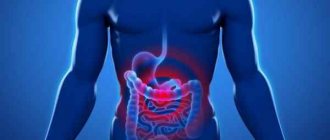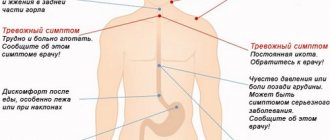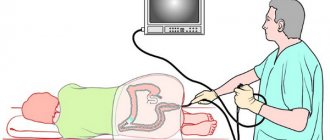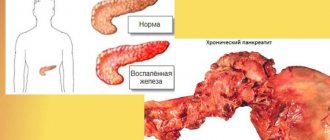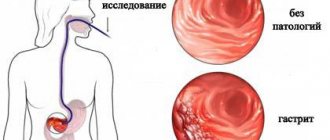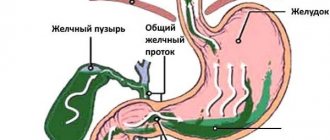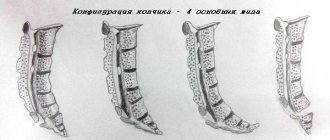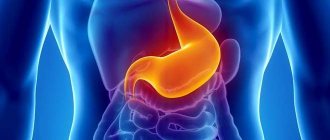Many diseases of the internal organs are indicated by pain in the stomach, often spreading to the entire area of the peritoneum and back. The pain syndrome is temporary or permanent and often indicates serious diseases of the digestive organs or other systems. To exclude severe complications, it is important to diagnose diseases that cause abdominal pain in their early stages.
Etiology
Pain in the epigastric region is caused by various ailments that affect many internal organs. Among the ailments, the most common causes of this symptom are:
- a wide range of diseases of the stomach, duodenum, esophagus and other gastrointestinal organs. In particular, chronic gastritis of various origins, hiatal hernia, pancreatitis and pyelonephritis;
- acute course of appendicitis. At the beginning of development, aching pain is noted in the navel area, then in the epigastrium, after which it spreads to the entire right side of the abdomen;
- myocardial infarction - can often be accompanied by painful spasms in this place. The pain is expressed quite acutely, and is also accompanied by a decrease in blood pressure and an increase in heart rate;
- pleurisy and pneumonia - with such disorders, pain in the upper abdomen sharply intensifies with strong coughing and inhalation, often the pain can radiate to the back;
- acute duodenitis – a slight pain syndrome appears, the sensitivity of this area increases, and signs of intoxication of the body are also observed;
- pyloroduodenal stenosis - characterized by the fact that pain is expressed after eating, accompanied by heartburn and frequent vomiting;
- various infectious disorders that cause sudden abdominal pain;
- hemorrhagic syndrome;
- typhus – differs in that it involves the solar plexus in the pathological process, thereby causing intense pain in this area.
Causes of pain in the epigastric region
But not only diseases can become a factor in the manifestation of unpleasant sensations in the epigastric region. Often the source of pain can be damage to other internal organs, in particular:
- stomach – there are severe and paroxysmal pains, often accompanied by other symptoms. Can occur both after meals and on an empty stomach;
- heart - in addition to the appearance of painful spasms in the epigastric region, pain spreads to the right shoulder and lower jaw;
- lungs - the intensity of pain varies depending on the breathing rate;
- pancreas - provokes constant and colicky pain, which can radiate to the back or left shoulder;
- intestines - almost always causes pain in the epigastrium, which is accompanied by many other signs;
- spleen – causes intense pain, often spreading along the left side of the body and neck;
- gallbladder - diseases associated with this organ often cause unbearable pain in the epigastric region, pain radiating to the back is often observed;
- kidney - sharp pain, spreading to the perineum and lower back;
- diaphragm - spasms in this area are greatly intensified during food consumption or deep breaths.
Another reason why epigastric pain may occur is oncology of one of the gastrointestinal organs or cancer metastasis.
Traditional medicine for chronic pancreatitis
Traditional medicine for pancreatitis
In folk medicine there are available recipes for the treatment of chronic pancreatitis. Here are a few of them:
- Wash potatoes and carrots well. The eyes of the potatoes are cut out and passed through a juicer so that 200 ml of juice is obtained. A serving is drunk within 30 minutes. Before eating.
- A glass of boiled buckwheat is poured with kefir overnight. In the morning, the portion is divided into two equal parts. You should eat one part instead of breakfast, and the second for dinner. After dinner with buckwheat, do not eat any more food.
- The oats are washed well, sorted, filled with water, and left in a warm place. After 2 days, the grains will sprout, after which they take a handful of sprouts, wash them again and let them dry. Dry raw materials are ground into flour. The resulting flour is diluted a little with cold water, then poured with boiling water and boiled for several minutes. After cooling, take instead of drinking. Under no circumstances prepare the decoction for future use, as it will lose its potency.
Epigastric pain: causes
Doctors of different specializations can identify the cause of pain. But if the patient regularly experiences pain in the epigastric region after eating, a comprehensive examination is prescribed.
This is done in order to identify the true cause of the discomfort and begin treatment of the pathology.
Before conducting an examination, the doctor prescribes a series of tests, including checking blood, urine, and feces.
What else does the doctor prescribe:
- Ultrasound of the abdomen.
- Various tests.
- X-ray of internal organs.
- Other procedures as prescribed by the doctor.
After all the tests and research results are collected, the doctor can make a diagnosis. To make sure of the diagnosis, the doctor must exclude the possibility of developing another disease that may occur with the same symptoms.
The doctor prescribes treatment based on the diagnosis. In the usual form of the disease, this can be outpatient treatment; pills, diet, and other precautions are prescribed.
If the patient is at a serious stage, hospitalization may be recommended.
If heaviness appears in the epigastrium, you should not wait until it goes away on its own; it is better to consult a specialist and identify the causes of pain. Be sure to undergo a full examination and begin treatment in a timely manner.
How quickly the discomfort in the epigastric region goes away depends on how effective the treatment is. The disease takes a lot of energy from a person, so you should not neglect your health.
Epigastric pain (orifice pain) varies widely. They may indicate a disease of one of the organs in which pain is felt. They can also be a symptom of more distant organ disease. Acute and prolonged pain in the epigastric region requires consultation with a doctor, and often even the intervention of a surgeon. Mild pain is usually easier to control.
Gastroesophageal reflux disease: a syndrome of complaints caused by the contents of the stomach into the esophagus, where the connection between the esophagus and the stomach occurs. The acidic contents of the stomach, retreating into the esophagus, cause unpleasant symptoms such as heartburn, belching, the return of stomach contents and a burning sensation in the esophagus. Burning and pain behind the sternum and in the epigastrium are also felt. The pain gets worse, especially when you lie down and bend over.
Gallstone: The disease is characterized by the presence of deposits in the gallbladder from chemicals found in bile. This is manifested by burning pain on the right side under the ribs, sometimes the pain radiates to the shoulder blade.
Gastric and duodenal ulcers: The disease may appear suddenly (acute ulcer) or as a chronic, recurring disease (usually associated with a duodenal ulcer). Its symptom is epigastric pressure that occurs several hours after eating. Duodenal ulcer is also characterized by so-called hunger pain.
Pancreatitis: Acute or chronic pancreatitis can manifest as severe bloating in the middle of the abdomen, which often radiates to the back. Severe pain in the epigastric region appears suddenly and intensifies over time. When the pain is severe, vomiting, diarrhea, and fever may occur.
Gastritis or duodenal mucositis: characterized by periodic pain in the epigastric region, abdominal discomfort, fullness and loss of appetite. The pain may be accompanied by illnesses such as vomiting, nausea, heartburn or gastrointestinal bleeding.
Stomach cancer. Epigastric pain appears after eating and disappears on an empty stomach. The pain also does not disappear after the administration of antacids, used, for example, for recurrent heartburn. The disease is also accompanied by a burning sensation in the stomach, nausea, flatulence, loss of appetite, feeling weak, vomiting, blood in the stool and disturbing weight loss.
VENTAL HEART MASK: This is a set of unusual symptoms of a heart attack, including pain in the epigastric region at the very top (mainly under the right rib arch). This pain is usually milder than with a classic myocardial infarction (sharp and nagging pain behind the sternum). Epigastric pain may be accompanied by nausea, vomiting and general weakness.
There are many more causes of pain in the epigastric region. Pain may appear as an unusual symptom of certain diseases or spread to the epigastric region and organs located there from afar.
- diabetes,
- thyroid diseases,
- cardiac ischemia,
- pneumonia,
- shingles,
- bile ducts and liver diseases.
The basis for the investigation of epigastric pain is a physical examination, that is, an examination consisting of auscultation (assesses intestinal motility), tapping (assesses abdominal sounds), kneading/pressure (assesses the occurrence of pain when touched, as well as muscle protection and the possible presence of tumors or ascites) and observation of the abdomen (allows assessment of skin changes or hernias).
Diagnosis of pain in the epigastric region also includes the study of Helmonski's symptom, that is, pain that occurs when a blow to the right rib, which is characteristic of cholecystitis. Also studied are the Blumberg sign, which is positive for peritonitis, as well as the Goldflam sign, which may indicate acute pyelonephritis or nephrolithiasis.
Epigastric pain, like any other, can be described as acute or chronic. It is important to characterize the type of pain when visiting a doctor. The painful sensations must be accurately described, and the pain must be characterized, for example, as girdling, squeezing, expanding, dull, burning, strong, throbbing or constant.
Important information is also the time when the pain occurs, whether it occurs after eating, when you feel hungry, or lasts continuously. The doctor should also be informed about all medications he is taking and medical conditions.
Treatment of pain in the epigastric region depends on the pain symptom. Special painkillers may help, although it's best to check with your doctor before taking them. Any type of pain, acute or chronic, should be consulted with a doctor. Treatment will depend on the diagnosis. Pain usually disappears after the cause is eliminated, for example, after the disease has been cured or its course has been weakened.
If you find an error, please highlight a piece of text and press Ctrl Enter.
If a person is bothered by pain in the epigastrium, then it is necessary to seek help from specialists such as:
- therapist;
- surgeon;
- neurologist;
- gastroenterologist;
- gynecologist;
- nephrologist;
- pulmonologist
After reviewing the medical history and life history, the doctor sends the patient, provided that he has complaints of pain and discomfort in the epigastric region, for an instrumental examination. This is necessary to establish the disease that caused such unpleasant symptoms.
Doctors are required to prescribe:
- general and biochemical analysis of blood and urine;
- microscopic examination of feces;
- breath tests to detect the bacteria Helicobacter pylori in the body;
- bacterial culture for antibodies;
- Ultrasound of the abdominal organs;
- FEGDS is an endoscopic procedure for studying the mucous membrane of the gastrointestinal tract;
- radiography - with or without contrast;
- biopsy - for histological studies and detection of oncology.
Based on the results obtained during diagnosis, specialists confirm the presence of a particular gastrointestinal disease.
If there is pain and discomfort in the epigastric region, then the elimination of a particular disease should be comprehensive.
First of all, drug treatment is prescribed. Regardless of the illness that caused the pain syndrome, drugs such as prokinetics and antacids are prescribed. They are aimed at relieving pain.
Dietary nutrition is important in therapy. Absolutely all patients are advised to avoid fatty and spicy foods, as well as smoked foods and carbonated drinks. In addition, long breaks between meals are not allowed, which is why it is necessary to eat small portions every three hours.
Surgical intervention is indicated in individual cases, with the acute course of the disease that caused pain in the epigastric region.
In addition, diseases can be treated with physiotherapy and the use of traditional medicine.
Diagnostics
For pain of any localization, it is necessary to undergo a full examination, since some diseases are fatal. Mandatory research methods:
- Ultrasound of internal organs. Helps diagnose cysts, fibroids, ovarian rupture, ectopic pregnancy.
- X-ray of the spine, stomach, intestines, kidneys. Detects osteochondrosis, intestinal obstruction, stomach tumors, and urolithiasis. To confirm intestinal obstruction, an x-ray with contrast is performed.
- MRI. It is the most reliable method. Detects the disease at the earliest stage. It can be used to differentiate a malignant tumor and assess the degree of organ damage.
- Fibrogastroscopy. Prescribed for stomach and duodenal ulcers.
- Laparoscopy is required to diagnose endometriosis.
- An ECG is performed on patients to rule out or confirm a heart attack.
- Blood is also taken from the patient for biochemical analysis.
- A general blood and urine test indicates the presence of an inflammatory focus.
In order to understand where the pain is coming from, you need to visit a doctor. The specialist will ask the patient about diet, daily routine, physical activity and other factors that could influence such an outcome. Then he will palpate the abdomen and back area. Find out the nature, duration and frequency of attacks. Will issue a referral for laboratory and instrumental studies.
If there is a suspicion of a heart attack, an electrocardiogram is required.
If there are problems with the gastrointestinal tract, the patient is sent to:
- Gastroscopy, or esophagogastroduodenoscopy (EGDS). The organ will be examined with a special flexible instrument with an endoscope attached to the end. The doctor sees the condition of the mucous membrane and any abnormalities.
- X-ray. If there are malfunctions, pain and heartburn, then this method will be advisable.
- Ultrasound examination (ultrasound). The result immediately appears on the monitor screen. The examination lasts no more than ten minutes.
- Study of gastric juice.
- Donation of blood, urine and feces.
If no problems with the digestive organs are found, then a targeted study of the spinal column is carried out. To detect osteochondrosis or neoplasms, they may be referred to:
- radiograph;
- computer or magnetic resonance imaging.
Classification
In gastroenterology, there is a clear division into the expression of pain in the epigastric region, which differs depending on what factor caused the appearance of such an unpleasant sensation. Thus, pain is divided into:
- hunger pains can be aching and severe. It goes away after eating food, and sometimes a few sips of tea are enough;
- constant - its occurrence is associated with irritation of nerve endings in the mucous and submucosal layer. Chronic pain syndrome is often observed during inflammation;
- periodic – often aching in nature and caused by the secretion of large amounts of gastric contents;
- contraction-like cutting.
In addition, pain in the epigastric region can be seasonal and worsen in spring or autumn.
Depending on food consumption, this symptom is divided into:
- pain in the epigastrium after eating - often observed after eating junk food, fast food, fried or salty foods, as well as low-quality food. In order to get rid of spasms, a person needs to take painkillers;
- pain that occurs on an empty stomach is eliminated after eating, and for this it is not at all necessary to eat to the full; in some situations it is enough to simply have a small snack. Quite rarely it can go away after drinking liquid.
Symptoms
Pain in the epigastric region can be the only symptom or be accompanied by other signs. It is necessary to seek help from specialists as soon as possible if, in addition to this symptom, the following clinical picture occurs:
- violation of respiratory function and the process of swallowing food;
- discomfort in the heart area;
- an increase in temperature above thirty-eight degrees;
- detection of blood impurities in feces and vomit;
- increase in abdominal size;
- increased pain, spreading to the back or right side.
Symptoms accompanying pain in the epigastric region
These are the main signs that may accompany hunger pain or the occurrence of cramps on an empty stomach in the epigastric region, and also indicate during diagnosis diseases of the gastrointestinal tract, heart and other internal organs.
Organs
In the area of the right hypochondrium are the liver, gall bladder, right kidney, and the initial parts of the small intestine.
In the left hypochondrium there are the spleen, some parts of the large intestine, the left kidney, and the pancreas.
The epigastric region, where the stomach is located, as well as the liver, duodenum, spleen, pancreas, and adrenal glands, is located in the center.
Characteristics of pain
The intensity and type of pain depends on the pathology that causes the discomfort. Many diseases of internal organs can provoke stomach pain. When an ulcer occurs, pain appears between the shoulder blades, it often spreads to the chest and lower back. Pain syndrome occurs mainly after eating or physical activity.
Often back and abdominal pain occurs due to inflammation of the pancreas. Accompanying the disease:
- cramping pain that comes on suddenly;
- feeling of abdominal distension;
- feeling of heaviness;
- vomiting that does not bring relief.
To prevent the transition of pancreatitis from acute to chronic, it is necessary to diagnose the disease as early as possible.
If pain in the stomach radiates to the lower abdomen and back, this most likely indicates the development of gastritis. Intense pain syndrome indicates an advanced stage of the disease, damage not only to the stomach, but also to other organs of the digestive tract - the pancreas, gall bladder, and spleen.
Pain in the peritoneum, severe weakness, increased heart rate, tachycardia, dizziness, and lightheadedness indicate myocardial infarction. If these symptoms develop, it is extremely important to call an ambulance and examine the patient.
Dull and aching abdominal pain is one of the possible signs of inflammation of the vermiform appendix of the cecum (appendix). About the causes of the disease - in the article Why can the appendix become inflamed? This creates:
- loss of appetite;
- repeated vomiting;
- constipation or diarrhea;
- rise in temperature;
- difficulty urinating and defecating.
Later, the pain syndrome is localized in the right region of the abdomen and becomes intense. To exclude peritonitis and other complications, you must urgently visit the hospital.
Abdominal pain often accompanies cholecystitis, an inflammatory process of the gallbladder. The discomfort radiates to the right side and covers the entire peritoneal area. The following symptoms occur:
- weakness;
- sweating;
- loss of appetite;
- bitterness, dryness of the oral mucosa;
- decrease in pressure.
Stomach pain often occurs with intestinal obstruction. This is a severe form of digestive system disorder, in which the movement of feces slows down. Characteristic manifestations are:
- aching pain spreading to the lower abdomen and left side;
- increased temperature, fever;
- spasm of the peritoneal organs;
- stool disorder;
- nausea;
- absence of gases and bowel movements.
The causes of this condition are strangulated hernia, stenosis, and intestinal adhesions.
Other causes of pain
In addition to diseases of the digestive system, stomach pain in women is provoked by ectopic pregnancy. In this case, the fertilized egg attaches to the folic tube, cervix, ovaries or abdominal cavity. This condition requires surgical treatment. The main method of intervention is laparoscopy. If a pathological pregnancy develops, pain occurs in the stomach area, radiating to the back, and the patient’s general well-being worsens.
Gynecological diseases often cause pain. These are fibroma, chronic adnexitis and some others. Pathologies of the respiratory tract are another cause of pain. Often, with pneumonia, the sensations are similar to an attack of radiculitis, a picture of an “acute abdomen.” Discomfort spreads to the left or right side.
The cause of abdominal pain is sometimes an inflammatory process of the bladder - cystitis. Other symptoms of the disease include pain when urinating, burning, chills, and high fever.
Pain on the right side under the ribs can be aching or burning and can spread to the chest and back. Such pain can also be a sign of diseases of various organs and a manifestation of the pathology of the digestive process: gallstones, peptic ulcer and hernia. Pain can often occur after eating, and it can become chronic.
Epigastric pain is a very common symptom. If heartburn occurs, it is gastroesophageal reflux disease.
Epigastric pain can occur during pregnancy. This is caused by hormonal changes that slow down the digestion process and due to mechanical reasons: the stomach becomes larger, the pressure in the abdominal cavity increases and causes discomfort. With increased pressure, pain in the epigastric region is an alarming symptom of preeclampsia.
People experience varying levels of soreness, ranging from mild to severe. Mild pain often occurs after eating, and it goes away quickly. Severe pain in the epigastric region, which also radiates to the chest and neck, can be so severe that it interferes with sleep.
Other symptoms in which the epigastric region of the abdomen is tense or painful: burping, bloating, cramping and hunger pains. Sometimes nausea, vomiting, sudden weight loss and poor appetite occur.
With irritable bowel syndrome, pain lasts quite a long time and is associated with bloating and changes in stool frequency or consistency. The examination is usually painless or may cause mild pain or a stretching sensation.
Peptic ulcer disease is characterized by acute or chronic gnawing or burning pain, especially if dietary recommendations are not followed. The pain is usually worse at night.
Pancreatitis is accompanied by acute pain that radiates to the back. This is usually accompanied by vomiting. When bending forward, the pain decreases. Signs of this disease vary but include jaundice, tachycardia, abdominal muscle rigidity, tenderness and discoloration of the skin around the navel or sides of the abdomen.
Peritonitis is acute pain with signs of shock and tension. This may get worse when you cough. The abdomen may be plank-shaped.
Gastrointestinal obstruction is accompanied by acute colicky pain. Vomiting brings relief. Accompanied by distension and auscultation of bowel sounds.
For diseases of the gallbladder, acute constant pain with vomiting, fever, local soreness and rigidity are diagnosed. In some cases, it is possible to palpate the gallbladder.
A ruptured aortic aneurysm is a sharp pain that radiates to the back or groin. The patient may have cardiovascular collapse. In this case, death occurs in the first minutes or in the first hours.
Stomach cancer is most often diagnosed in male patients who are over 55 years old and who smoke. In advanced cases, weight loss, vomiting, hepatomegaly and dysphagia may occur.
Pain in the epigastric region can also be of psychosomatic origin.
Which doctor should I contact?
If pain occurs repeatedly, it is advisable not to delay visiting the clinic. The best solution would be to visit a therapist who will conduct an initial examination. This will help determine the further course of action and schedule a consultation with a specialist. If you have back or abdominal pain, you may need help:
- Neurologist;
- Urologist;
- Gynecologist;
- Orthopedist;
- Surgeon;
- Gastroenterologist;
- Endocrinologist.
In rare cases, there is a suspicion of a tumor or cyst, to exclude which you need to consult an oncologist and undergo additional tests.
The inflammatory nature of the disease can be determined by blood and urine tests. And tomography, ultrasound and x-rays will exclude organ pathologies.
Serious and life-threatening causes
Pain in the epigastric region is not always a manifestation of a serious illness. However, you should contact your doctor immediately if you experience symptoms such as:
- labored breathing,
- pain in the heart area,
- bloating,
- blood in the stool along with vomiting,
- fever above 38,
- abdominal pain intensifies and/or moves to the lower right region.
There are many reasons that can cause pain in the epigastric region. Diverticulitis, lactose intolerance and GERD can cause this symptom. Another possible cause of discomfort is inflammatory diseases and even cancer, which affects the functioning of the stomach and other digestive organs. In rare cases, heart disease also leads to pain in the epigastric region.
Overeating, consumption of spicy and fatty foods, and alcohol are well-known factors that lead to the epigastric region becoming painful both at rest and during examination. Drinking coffee too often leads to stomach upset. This drink also interferes with GABA metabolic activity, which is very important in calming the gastrointestinal (GI) tract.
Some other diseases that cause pain:
- Gastritis is a condition in which the lining of the stomach becomes inflamed and sensitive.
- Peptic ulcers are open sores or ulcers in the lining of the stomach and small intestine.
- Dyspepsia or upset stomach.
There are other diseases in which the epigastric region becomes painful. This:
- inflammation of the esophagus, also known as esophagitis;
- hiatal hernia;
- pancreatitis;
- diverticulitis;
- stomach cancer;
- oncological processes in the pancreas;
- hepatitis;
- chronic cough;
- stretching of the abdominal muscles;
- abdominal aortic aneurysm;
- side effect from taking medications.
With some forms of urethritis and other inflammatory diseases of the pelvic organs, pain in the epigastric region sometimes occurs, which is usually accompanied by fever and nausea.
Myocardial infarction and angina pectoris are diseases that can also cause pain in the epigastric region. In this case, there is the effect of reflected pain, which can begin not only in the heart area, but also in the pleura or spinal nerves in various diseases.
Prevention
Preventive measures are to prevent diseases. This is achieved using:
- Proper nutrition.
- Giving up bad habits.
- Prevent hypothermia.
- Timely treatment of infectious diseases.
- Regular preventive medical examination.
Preventive measures for abdominal and back pain mean:
- Review your diet. You need to eat balanced and healthy food. Avoiding fried, smoked, fatty foods, alcohol and problems with the gastrointestinal tract will not arise. Eat vegetables, fruits, meat, fish, cottage cheese regularly, drink milk, kefir and more other liquids.
- Control your weight. Avoid obesity and hints of it. Excess weight destroys joints, cartilage, and overloads the spinal column.
- Limitation in physical activity. To prevent the development of osteochondrosis, try not to lift heavy objects.
- In systematic training. Go in for sports, dancing, fitness, swimming.
- Promptly going to the hospital if there are any abnormalities.
Diagnostic tests
Various studies are carried out to diagnose the underlying causes. The use of modern technology plays an important role in achieving excellent results in detecting the affected area of the body. Below are the most common methods:
- The erythrocyte sedimentation rate (ESR) is an inexpensive and simple test that is used to detect inflammation in the body.
- A urine test is performed to detect urinary tract infections and other underlying conditions.
- A biochemical blood test is performed to determine liver function and the content of pancreatic enzymes.
- An endoscopy is usually performed to evaluate problems related to the stomach and esophagus. This test also provides the ability to perform a biopsy, which detects abnormalities such as inflammation, ulcers and tumors.
- X-rays and ultrasounds of the abdomen are done to check the abdominal organs (stomach, kidneys, intestines, bladder, liver and pancreas) to identify obstructions or other pathologies.
- MRI and CT scans are very helpful in uncovering the root cause of pain.
- An ECG is performed in cases where epigastric pain is not associated with gastrointestinal diseases. This test helps in diagnosing heart attacks.
Why does it occur
Pain in the stomach can indeed radiate to the back on the right or left, most often in the hypochondrium or between the shoulder blades, less often in the lower back.
This is due to the fact that the nerve endings of the abdominal organs represent a single network with the nerve fibers of the back and spinal cord, as a result of which discomfort is felt in several places at once.
Only a doctor can determine the exact cause of the discomfort.
If you experience abdominal pain radiating to the back, you should not discount cardiovascular pathologies, since they can also be accompanied by similar manifestations.
Answering questions about whether the back can hurt from the stomach and when this happens, it should be noted that all organs included in the digestive system communicate with the spinal cord through nerve fibers. The abdominal control center is located primarily in the thoracic and lumbar spinal cord.
Based on the nature of the manifestation, 3 categories of pain can be distinguished:
- Pulling and aching are characteristic of gastritis, diseases of the female reproductive system.
- Paroxysmal, dull pain appears with hepatic colic, cholecystitis, urolithiasis, and increases as stones pass through the ducts.
- Acute and intense painful sensations are characteristic of ulcers, pancreatitis, and appendicitis.

